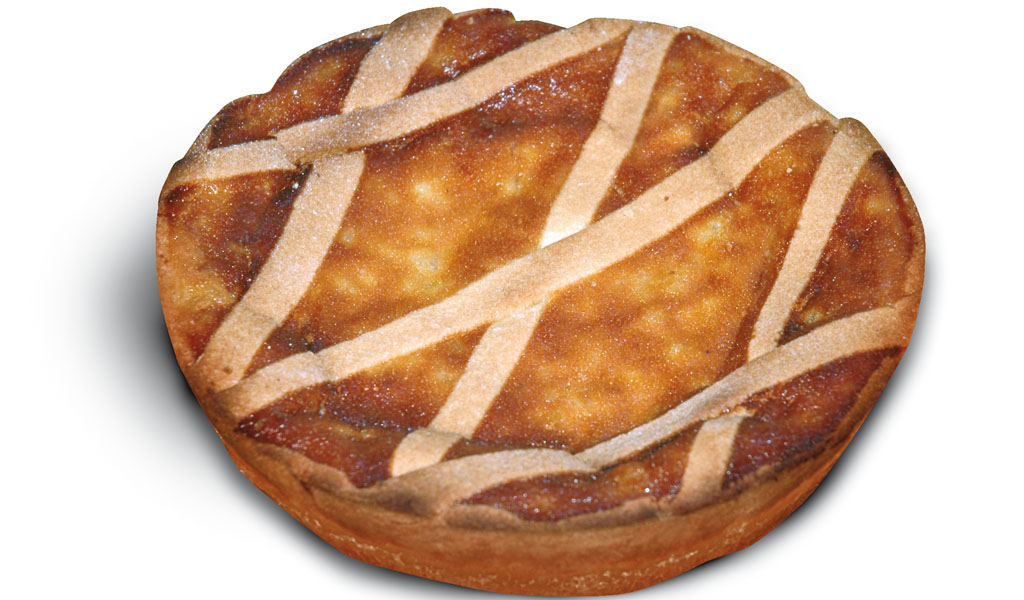Prodotti tradizionali
Pastiera

La pastiera è il dolce pasquale napoletano per eccellenza: famosissimo in tutto il mondo e immancabile sulle tavole campane. è costituito da una base di pasta frolla tradizionale, riempita da un composto ottenuto da ricotta, zucchero, strutto, grano duro cotto, uova, acqua di millefiori e vaniglia, la cui parte superiore è decorata dalla restante parte di pasta frolla tagliata a striscioline, che vengono distribuite in modo da formare delle losanghe. La pastiera viene, poi, cotta in forno e spolverata di zucchero a velo. La sua origine è legata ad una leggenda che vede come protagonista è la sirena Partenope. Costei dimorava nel golfo di Napoli e ogni primavera emergeva dalle acque per cantare per gli abitanti del golfo; un anno il suo canto fu così straordinario che tutta la popolazione accorse verso il mare portando a Partenope dei doni per ringraziarla. La sirena ricevette la farina, cioè la forza e la ricchezza della campagna, la ricotta, omaggio dei pastori, le uova, simbolo della vita che sempre si rinnova, il tenero bollito nel latte, a prova dei due regni della natura; l'acqua di fiori d'arancio, per rappresentare i profumi della terra, le spezie, in onore dei popoli più lontani del mondo ed infine lo zucchero, per esprimere l'ineffabile dolcezza profusa dal canto della sirena. Quest'ultima, felice per tanti doni, li depose ai piedi degli dei, che riunirono e mescolarono con arti divine tutti gli ingredienti, trasformandoli nella prima Pastiera. Di vero, in quest'affascinante leggenda c'è sicuramente il legame con la primavera: pare, infatti, che le antenate delle pastiere fossero preparate in occasione delle antiche feste pagane che ne celebravano il ritorno. La versione odierna fu realizzata delle suore dell'antichissimo monastero di San Gregorio Armeno, che vollero celebrare la Risurrezione mediante una simbologia che unisse il profumo dei fiori dell'arancio del giardino conventuale con la bianca ricotta ed il grano e le uova, simbolo di nuova vita, l'acqua di mille fiori odorosa come la primavera, il cedro e le spezie asiatiche. Da allora le suore, divenute maestre nella complessa manipolazione della pastiera, nel periodo pasquale ne confezionavano in gran numero per i nobili ed i ricchi borghesi. La pastiera va confezionata con un certo anticipo, non oltre il Giovedì o il Venerdì Santo, perché si riposi e tutti gli ingredienti si amalgamino bene tra loro all'interno dei tipici ruoti di ferro stagnato dove viene cotta, servita e finanche venduta, poiché è talmente fragile che a sformarla si rischia di disfarla irrimediabilmente.
Pastiera is the most typical Easter Neapolitan cake of all; famous all around the world and ever-present on every table in Campania. A base of traditional short pastry, filled with a mix of ricotta, sugar, lard, duram wheat, eggs, perfume flower water and vanilla; the top is decorated with short pastry stripes positioned to look like lozenges. Pastiera is then cooked in the oven and sprinkled with icing sugar. The legend tells that the mermaid Partenope lived in the gulf of Naples and emerged every Spring to sing to the local population. One year her songs were so good that the whole population ran to the sea to bring her gifts in gratitude. The mermaid received flour, symbol of strength and richness of the country; ricotta, gift of the shepherds; eggs, symbol of life reborn; soft grain boiled in milk, proof of the two realms of nature; orange flower water, representing the earth's scent; spices, to honour far away populations and finally sugar, to express the mermaid's intangible sweetness. Partenope, was so happy for the many gifts, that she lay them down by the feet of the gods who assembled the ingredients together and with their divine artfullness created the first pastiera. For sure the bond with Spring in this fascinating legend is true, it seems like pastiere where prepared in ancient heathen celebrations for the return of the season. The modern version was created by the nuns of San Gregorio Armeno's monastery to celebrate the Resurrection through the symbology which unified the scent of the convent's orange gardens, the white ricotta, grain and eggs, symbol of new life, perfume flower water which smelt of Spring, citron and Asian spices. Since then the nuns, masters of the difficult manufacturing process, produced many pastiere for the noble and rich families. Pastiera must be done quite in advance, not after Thursday or Good Friday, so that it can rest and all the ingredients are put together in the typical round tin pans, in which it's cooked and even sold because otherwise it would break.